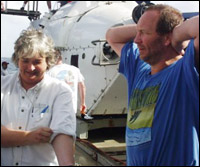Plans for the lab back home
Once ashore, Kelley will take the samples to the University of Washington for much more detailed studies, using tools like scanning electron microscopy, x-ray diffraction, and DNA analysis.

Fig. 10. Debbie Kelley and John Karson as they emerged from Alvin after a successful dive.
Followup studies by Frueh-Green's will include analyses of differing forms of the same atomic elements, called "isotopes." The ratio of Oxygen-18 to Oxygen-16, for example, can help determine the temperatures at which mineral samples interacted with water during their formation.
Meanwhile, Kelley will be analyzing rock chemistries and structures searching for microscopic pockets in the rock samples - called "fluid inclusions" where hydrothermal fluids can be trapped in gas or liquid form. Those inclusions can help tell stories about the temperatures and chemistry of older venting fluids.
Fluids can be trapped as far down as 2-4 kilometers beneath the seafloor. "After the magma chamber cools down, crystallizes, and becomes solid rock, the rocks crack and fracture," she said. "As they fracture, seawater circulating from the seafloor down through these fault systems extracts heat from the rocks. So the rocks cool even more, and they crack more - creating a complex feedback loop.
"And as the hydrothermal fluids react with the rock at temperatures as high as 700 degrees centigrade they leach out metals and other chemical species. And they also form abiogenic methane."
"Abiogenic" means methane made by chemical reactions instead of biological ones. Kelley and Frueh-Green are world leaders in probing the creation of abiogenic methane, as well as hydrogen, in crystallized remnants of magma chambers.
They are also looking for it further down underneath magma chambers in the mantle itself, which is why they are so interested in this vent field. Here, the peridotite host rocks may tie the chemistry of hydrothermal fluids to the mantle.
Preliminary analyses aboard Atlantis shows that peridotite rocks at the site are interacting with seawater to alter them into serpentinites, a process called "serpentinization." "The minerals that form peridotites are unstable and reactive," Kelley said. "During reactions with seawater, methane and hydrogen are formed. Both are very good nutrients for microorganisms."
Such microorganisms may differ from those normally found at hydrothermal vents in volcanic basalt producing environments. That's because "within basaltic systems they commonly use carbon dioxide as a nutrient source," she added. "Early in Earth's history, hydrothermal thermal systems were likely to be in peridotite type rocks. It's within such systems that early microbes may have evolved."
While the puzzles of this new and unexpected vent field may take years of followup work to completely unravel, expedition scientists have already made one decision.
They have given the site a name that also relates to the ship they're aboard, as well as to a nearby transform fault. Harkening back to the Greek myth of the sunken civilization called Atlantis, it will be called "The Lost City."
Today's pages:
"When I first saw them ..." | The towers | "... how little we know" | Life between a rock and a hot place | Plans for the lab back home

| |
|


